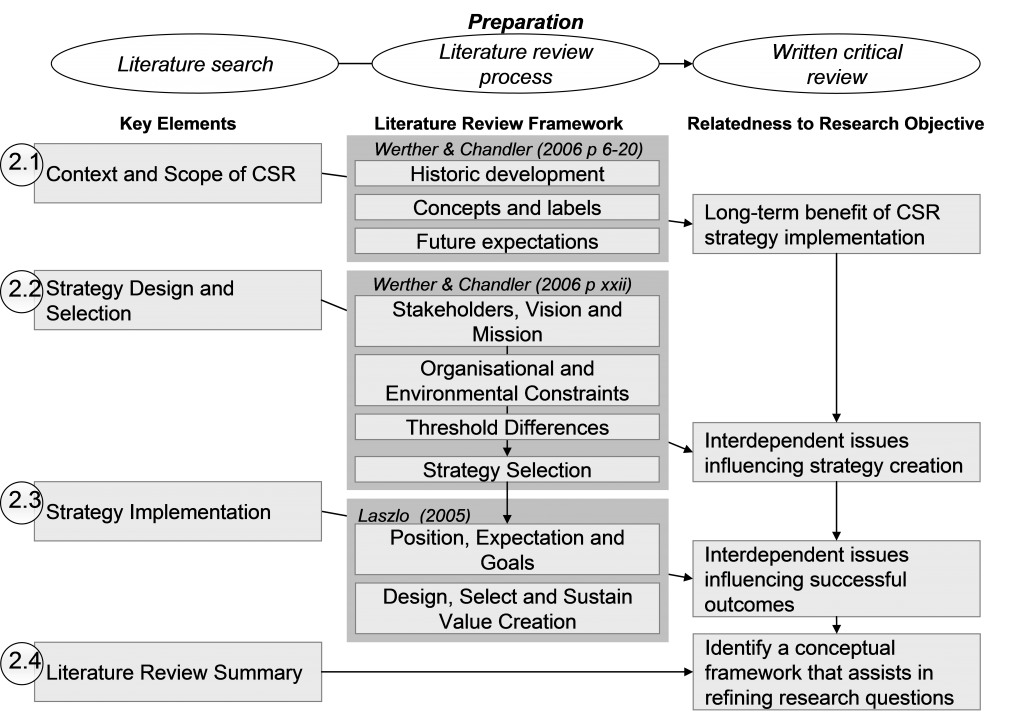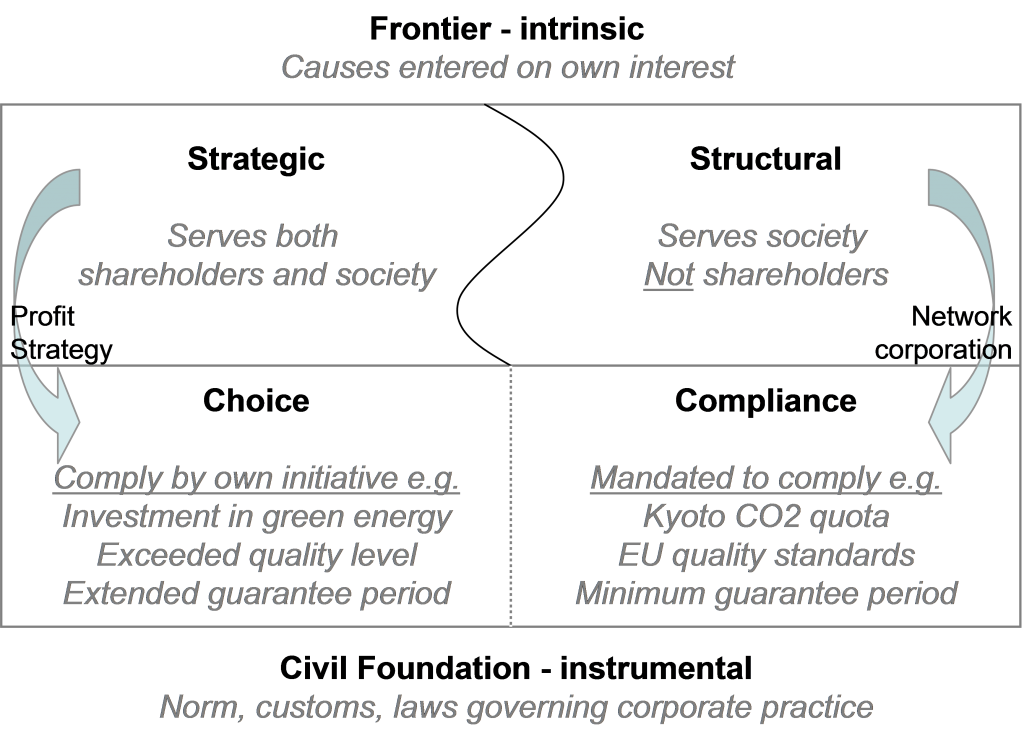2. LITERATURE REVIEW OF STRATEGIC CSR
To develop a richer understanding of strategic CSR the research moves through a series of literature to identify a conceptual framework that assists in refining field research questions (figure 3).
Figure 3: Thematic Framework of Literature Review

Source: Author’s own creation
Figure 16 provide a framework of literature review reference.
2.1 Context and Scope of CSR
The emergence and ongoing development of CSR is reviewed to secure a foundation for understanding the concepts related to the topic, and to determine the different approaches towards CSR described in academic literature.
Supplementing detailed information concerning the historic evolvement of CSR and the stakeholders in CSR can be found in appendix 2.
2.1.1 Historic Development
Description of the emergent development of CSR is based on different sources in literature. Makover (1994) summons up the development and understanding of business ethics and social responsibility and illustrates by case studies. Frederick (2006) also presents a thorough case based historic description of the CSR evolvement.
Vogel (2006) offers a good analysis of the evolvement of CSR and the driving forces in society. Based on Vogel’s link between CSR motivation and social change the changing CSR labels are illustrated in figure 4.
Figure 4: Business Context, CSR Motivation and CSR Labels

Source: Author’s own creation
Early CSR literature focused on Stewardship balancing stakeholder expectations (Lipman, 1912) as a consequence of increasing separation of ownership and management.
Social welfare focus and philanthropy interest increased after Second World War mainly based on owners self interest, and in the 60s and 70s percentage donations of revenue were widely used.
Society agenda during the 70s caused investor relationship improvements to be in focus, and the free market focus in the 80s gave birth to cause-related marketing with increased sales and profit as motivation.
The increasing globalisation and internet use has changed business focus in the 90s and the new millennium to be more socially responsible and aligned to global and local culture. Ethical responsibility is of increasing use in business visions.
The interdependence between society and business development is described by Frederick (2006 p26) “One outcome of business-induced social change is the emergence of a group of social revolutions”.
If business historically has induced or reacted to social change seems to be a key discussion point in literature.
The key point made by Frederick (2006 p146) is the importance of coexistence with stakeholders “Because corporation and community comprise one large coevolving, nonlinear system, business’s civic role is ever-evolving, always indeterminate, a moving target”.
2.1.2 Concepts and Labels
The moving target, as described by Frederick, seems to have caused CSR to be a case of constant redefinition. Makover (1994 p12) concludes that “there is no consensus on a definition of the term socially responsible. Far from it”.
To better understand what CSR presently comprises several sources of literature have been reviewed.
Hopkins (2003 p10) describes different concepts, labels and abbreviations that give a better understanding of the different scopes of CSR. Some definitions match with other definitions in literature and some not.
It seems that defining what CSR might not be, could at least give a better idea of the concepts.
Milton Friedman wrote in his book Capitalism and Freedom (1982) “The corporation is an instrument of the stockholders who own it. If the corporation makes a contribution, it prevents the individual stockholder from himself deciding how he should dispose of his funds”.
This view is widely criticised in CSR literature. Goodpaster & Matthews (1982 p145) holds the view that it is not sufficient to draw a sharp line between private ideas and business actions. Handy (2002) criticises the movement during the 80s where Regan/Thatcher gave more freedom to the corporations, mainly driven by Friedman’s views of the free market.
Friedman’s view of separating the society agenda into social politics and business profits is also countered by Hopkins (2003), McMillan et al (2004) and Laszlo (2005 p46). The authors promote the view that corporations are to take a stakeholder view and balance both sides of the coin, by ethical and responsible relationship management and corporate governance direction and control.
The ethical stakeholder responsibility is well illustrated in Kyosei (Kaku 1997). Kyosei can be defined as the spirit of corporation for the common good. Ryuzaburo Kaku, chairman of Canon, describes the spiritual principles in Canon and the idea that corporations are to directly influence governments to act on global imbalance. This approach seems to be close to pure philanthropy.
Werther & Chandler (2006 p xvii – xviii) criticise both ends of the spectrum for not balancing a successful alignment.
The shift towards a balanced focus seems best described by Hopkins (2003 p17) as “it is appropriate to revise Friedman’s aphorism from one of social responsibility or profits to one of social responsibility and profits. This is the new bottom line!”
Convergence of interests between pure philanthropy and pure business is well illustrated by Porter & Kramer (2002 p34). They illustrate with case studies how Corporate Philanthropy, if managed to maximize value (figure 5), can influence the competitive context and create competitive advantage. The simple model creates a good foundation for understanding the potential benefits of CSR and addresses the need for effective selection of and cooperation with stakeholders.
Figure 5: Convergence of Interest – Maximizing Philanthropy’s Value

Source: Porter & Kramer (2002 p34 & 45)
The label Virtue is of increasing use as Vogel (2006 p2) defines it “CSR or virtue is practices that improve the workplace and benefit society in ways that go above and beyond what companies are legally required to do”.
The need for exceeding the legal requirements are supported by Kotler & Lee (2005 p3) as a commitment to improve community well-being through discretionary business practices. They emphasise that the word discretionary means not mandated by law or expected by morals and ethics, and that CSR is voluntary commitment in choosing and implementing practices or contributing with corporate resources.
As social expectations change the threshold discretionary level is however changed as well and new responsibilities need to be aligned to stakeholder expectations (Caroll, 1991).
The continuous changing frontiers of strategic social responsibility versus structural compliance to threshold responsibility are well illustrated and described in the “Virtue Matrix” (Martin, 2002). The matrix transforms CSR from a rather subjective concept into a defined model.
The model (see figure 6) categorizes CSR or environmental practices. The bottom quadrants represent the pre-existing observance of CSR, the left voluntary actions that follow norms and customs, and the right compliance with regulations and laws.
At the frontier level at the top companies take risks and must relay on intrinsic value of actions. The arrows illustrate that either structural collective action or corporate innovative strategy that are imitated can lead to a raise in civic foundation.
The strategic CSR initiatives are based on a profit maximising strategy, while the structural initiatives only share the benefit of society.
Figure 6: The Virtue Matrix

Source: Adapted from Martin (2002 p103)
According to Vogel (2006) the motivational factors in adopting CSR are either opportunity driven or threat/risk driven. The motivational factors described by Vogel support Martin’s (2002) Virtue Matrix.
Threat/risk driven organisations are more likely to adopt a defensive strategy, motivated by the necessity to avoid a competitive disadvantage created by external pressure.
Opportunity driven organisations see CSR as a part of business identity and offensive differentiation strategy. Vogel describes the concept of social entrepreneurship as business with the purpose to achieve social or environmental goals. New product concepts such as Fair Trade, Ethical, Organic and Green Products are outcomes of social innovation.
Importance of Corporate Social Innovation is discussed by Rosabeth Moss Kanter (1999) as a critical factor for corporation’s ability to utilize community needs to develop ideas, demonstrate business technologies, find and serve new markets and solve long-standing business problems. On the basis of this definition Moss Kanter defines CSR as an area of strategic investment.
In the historic perspective, business’ role in social change was determined as a key discussion point. The convergence of interest between business and society and the virtue matrix assists in determining that business is both reacting to changes in social threshold levels and investing in innovative strategies that induce social change.
2.1.3 Future Expectations
To prioritize and enable investment in future CSR initiatives the need for building a business case seems necessary. However this offers a challenge as CSR is a moving target that is much different than it was five or ten years ago, and will continue to evolve (Vogel 2006 p xxi).
McMillan et al (2004) sees that the elements driving enhancement of the intangible assets constituting shareholder value, are to be found in the future behaviours of key stakeholders towards the firm.
The drivers of the future CSR agenda determined by Frederick (2006 p58-59) are among others environmental pollution. Future generation of more socially committed managers (Vogel 2006 p xxi) is also expected to lead to more responsible leadership. Change in social and ethical expectations, free flow of information and increased brand trust is expected by Werther & Chandler (2006 p19-20) to be trends influencing CSR relevance.
These assumptions seems to fit well to the Y generation that is expected (Junco & Mastrodicasa, 2007) to be fully online, more ambitious, more brand conscious and more attached to the business culture as they see their job as a part of their identity.
To secure long-term value creation of investments in social innovations it seems that there is a need for establishing a strategic CSR context, which enables scenario building and selection of initiatives.






